Photography courtesy of Lowell Washburn, all rights reserved.
The lead colored skies were dark and somber. Around two inches of new snow had fallen during the night and the weatherman was promising more on the way. Flurries, in the form of huge dry flakes, were continuing to fall. Wind chills were pushing minus twenty degrees. Up at International Falls, the actual temperature had plummeted to a brutal negative 37, making it obvious that things weren’t likely to warm up anytime soon. In other words, it was shaping up to be the kind of day that Iowa goose hunters live for.
Although the Canada goose is about as weather resistant as a water bird can get, even these hardy creatures have their limit. And as the jet stream continued its plunge, thousands of southbound wild geese were coming with it. It is impossible to know exactly how many geese invaded Iowa during the closing days of December; but it is safe to say that the migration was one of the most dramatic in a long long while.
For those who enjoy Iowa’s out-of-doors, there are plenty of things to do this time of year. Of course, not everyone shares my enthusiasm for winter weather. For most folks, the idea of putting out a big spread of goose decoys and then spending the day laying on a windswept, snow covered hilltop on the off chance that a not so bright goose might happen to mistake your counterfeits for the real thing and come sailing in, probably wouldn’t qualify as “the best time ever”. Consequently, I ended up hunting alone.
Although I had yet to see or hear a goose, I was optimistic. When it comes to late season waterfowl hunting, snow is the Great Equalizer. It doesn’t seem to matter that Canadas are carrying enough winter fat to start a candle factory. Once local corn fields are covered with a couple inches of white stuff, honkers will immediately think they’re on the verge of starvation. Fresh snow cover will decrease the IQ of a Canada goose by 50 percent, sometimes even more.
Once my decoys were in place, there was nothing to do but wait. For the first three hours, the gray skies remained empty. My sole companions were a group of horned larks foraging in the stalks. I wondered how anything so tiny could survive life in an open corn field. There were no other birds. Despite their recent increase in numbers, recently arrived goose flocks were staying put on the ice. And so, the waiting game continued as did the wind and snow flurries. As the minutes ticked by, I began dreaming of hot pancakes. I was about to pour the syrup when the sound of approaching geese jolted me back to reality.
The flock contained around a dozen birds and although locked onto the decoys, the group made a last-minute adjustment and landed a few yards upwind. I heard more geese and a wavering line containing more than 50 Canadas soon appeared through the gloom. Setting their wings in unison, the birds began their descent. Within seconds, the giant fowl were over the decoys. Sitting up, I managed to down a bird with each barrel.
It was Game On. The flight had begun, and the lonely corn stalks had suddenly become my personal Field of Dreams. For the next 2 ½ hours I was treated to the noisy spectacle of nonstop flocks of incoming Canada geese. The never-ending procession came in small bunches, long undulating lines, and massive groups containing upwards of 75 Canadas. Although I could legally bag one more goose, I hesitated to shoot into those big flocks — a surefire way to re-educate the Canadas and ruin the field for future hunts.
As the flight continued, some of the geese began landing just over the hill from where I sat. They soon attracted more geese. I tried to count the incoming birds, but couldn’t keep up. Within a half hour, I estimated there was somewhere in the vicinity of 900 to 1,000 Canadas feeding beyond the hilltop. I heard a closer honk from behind and turned to spot a lone Canada winging across the sky. When I called, the bird set its wings, dropped the black webbed landing gear and came straight to the decoys.
With a third goose now in the bag, I sat back to enjoy the show. Although most of the flocks ended up joining the feathered hordes already on the ground, a good number continued to inspect my decoys. By now, the noise level was probably exceeding OSHA safety standards. Another single appeared, locked onto the decoys, and landed.
It was late afternoon when I finally decided to call it quits and pick up while there was still light. Setting my camera on top of a decoy, I set the timer and took a couple of souvenir selfies. Amazingly, I was able to load the decoy trailer and truck without spooking any of the birds feeding over the hill. Happily, this made the prospect of a repeat event a likely possibility. But regardless of what tomorrow would bring, today’s goose extravaganza had definitely been one for the Log Book – a day I’ll remember long after the season is over.
LW

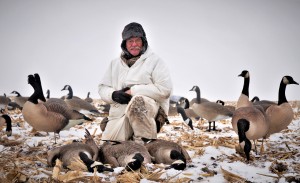
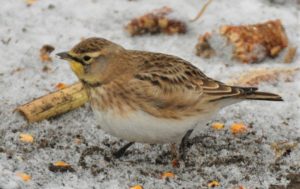

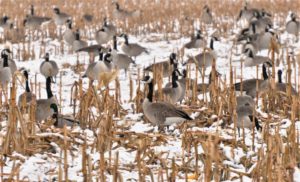
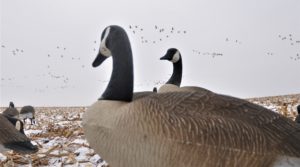
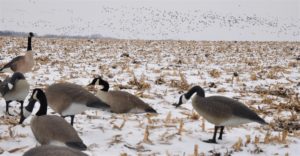
 Tom Cope
Tom Cope Sue Wilkinson
Sue Wilkinson Susan Judkins Josten
Susan Judkins Josten Rudi Roeslein
Rudi Roeslein Elyssa McFarland
Elyssa McFarland Mark Langgin
Mark Langgin Adam Janke
Adam Janke Joe Henry
Joe Henry Kristin Ashenbrenner
Kristin Ashenbrenner Joe Wilkinson
Joe Wilkinson Dr. Tammy Mildenstein
Dr. Tammy Mildenstein Sean McMahon
Sean McMahon